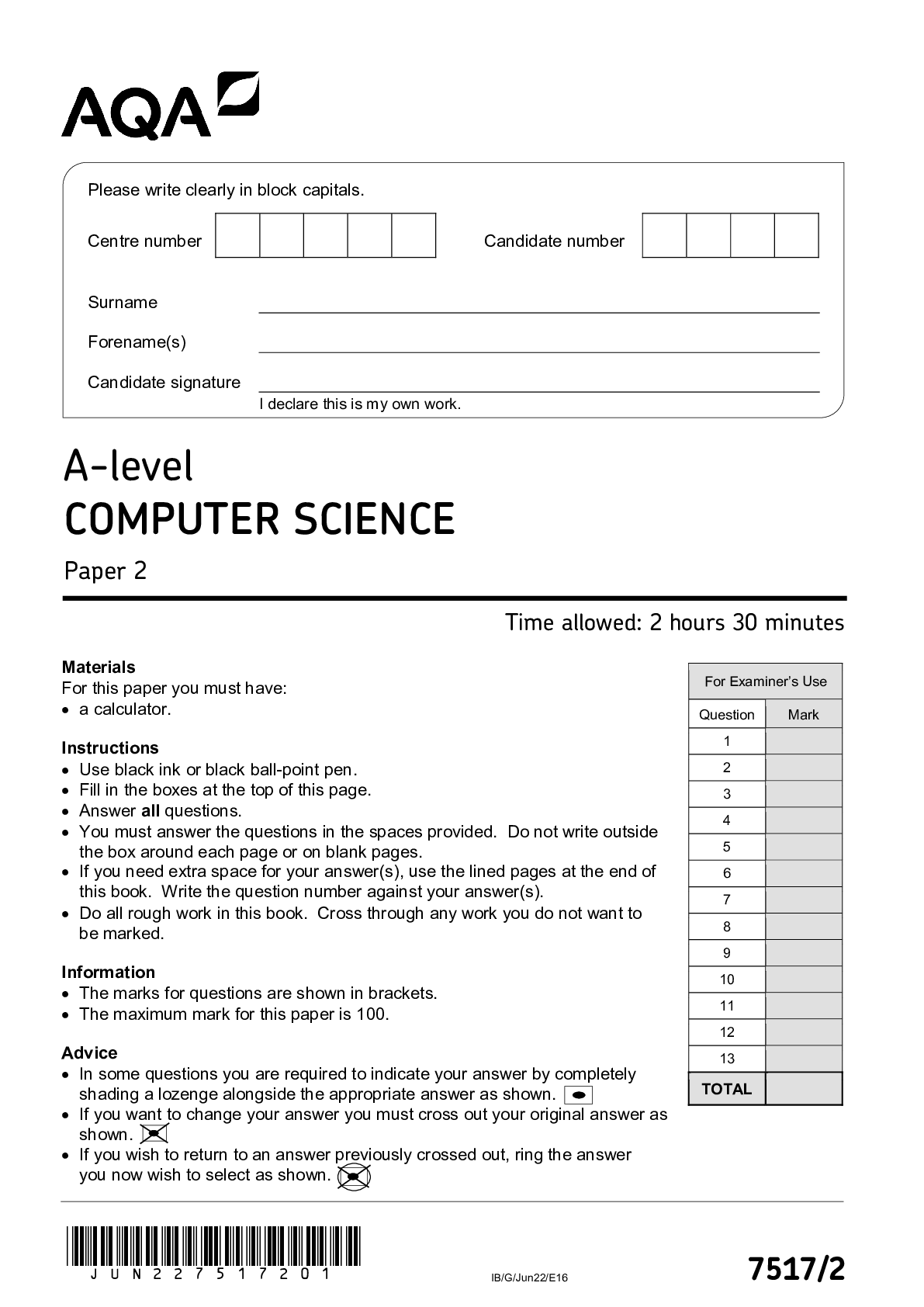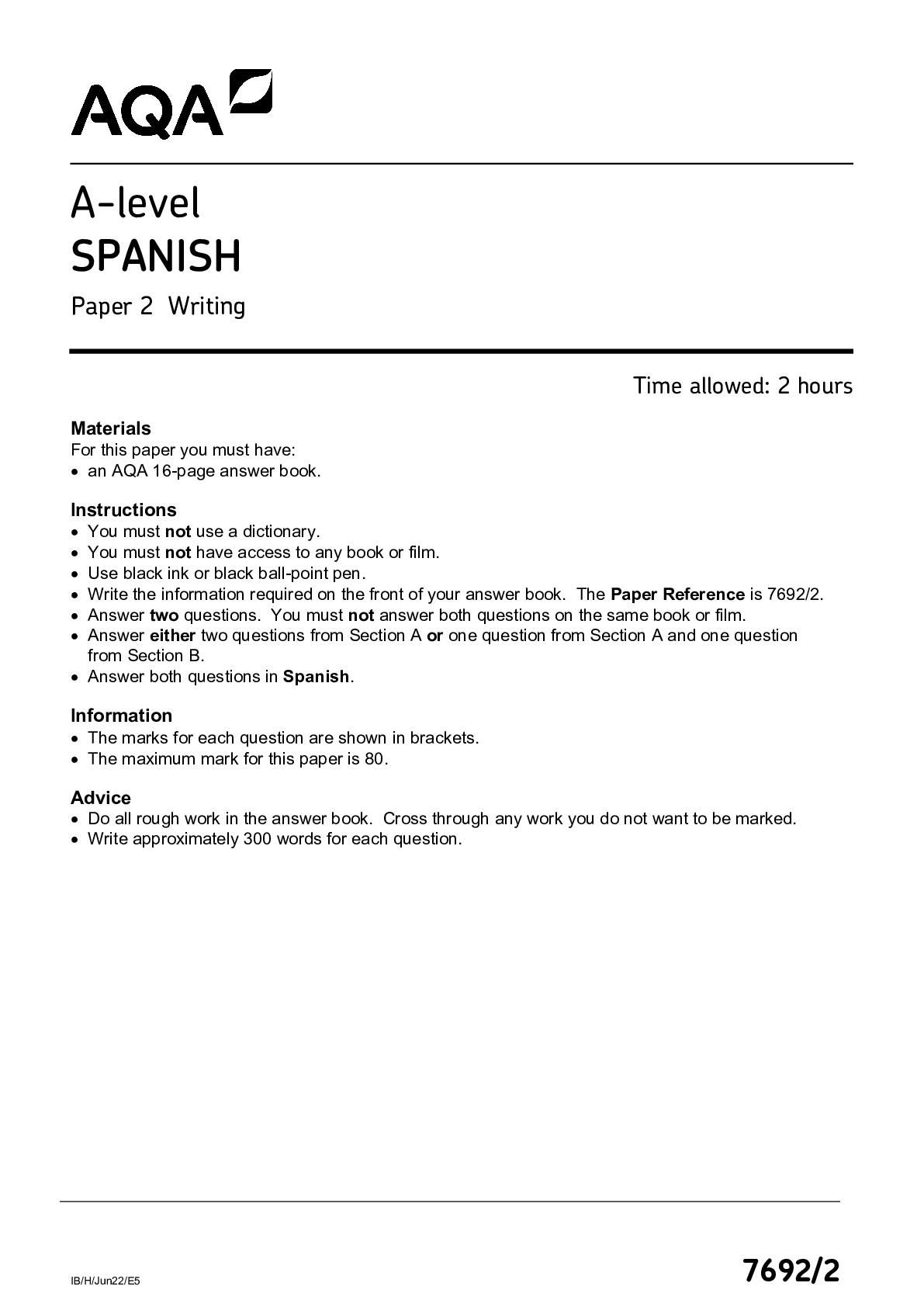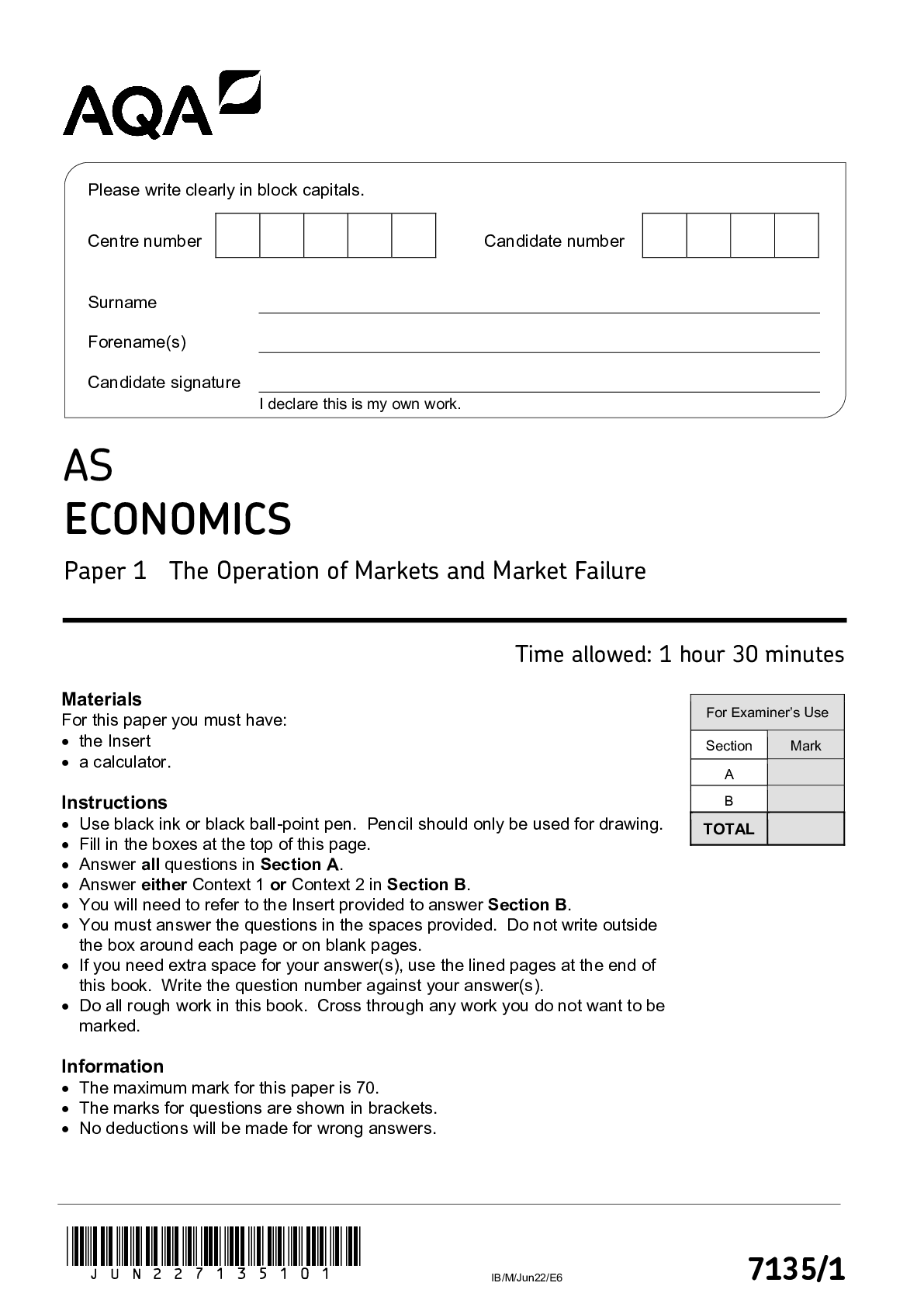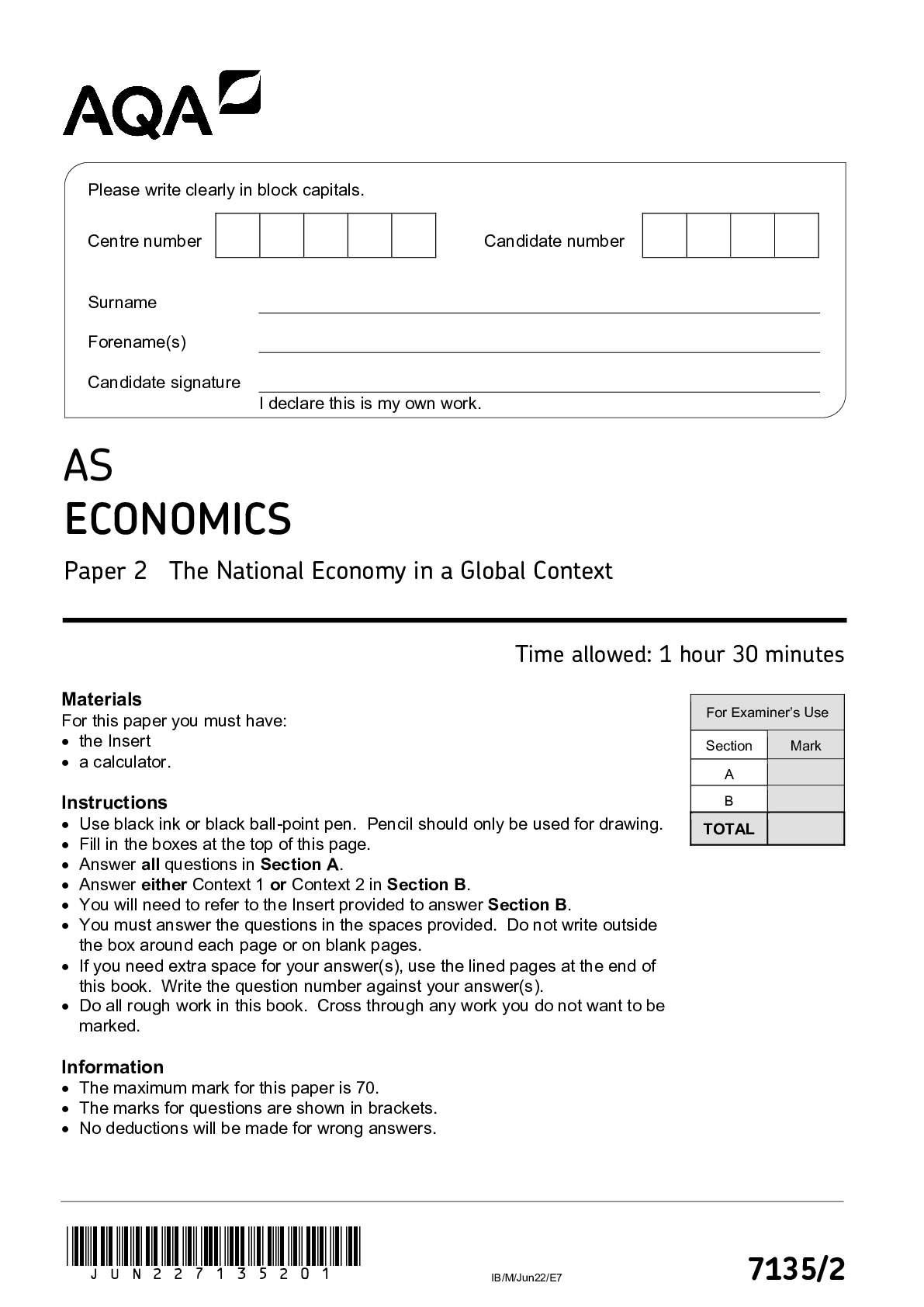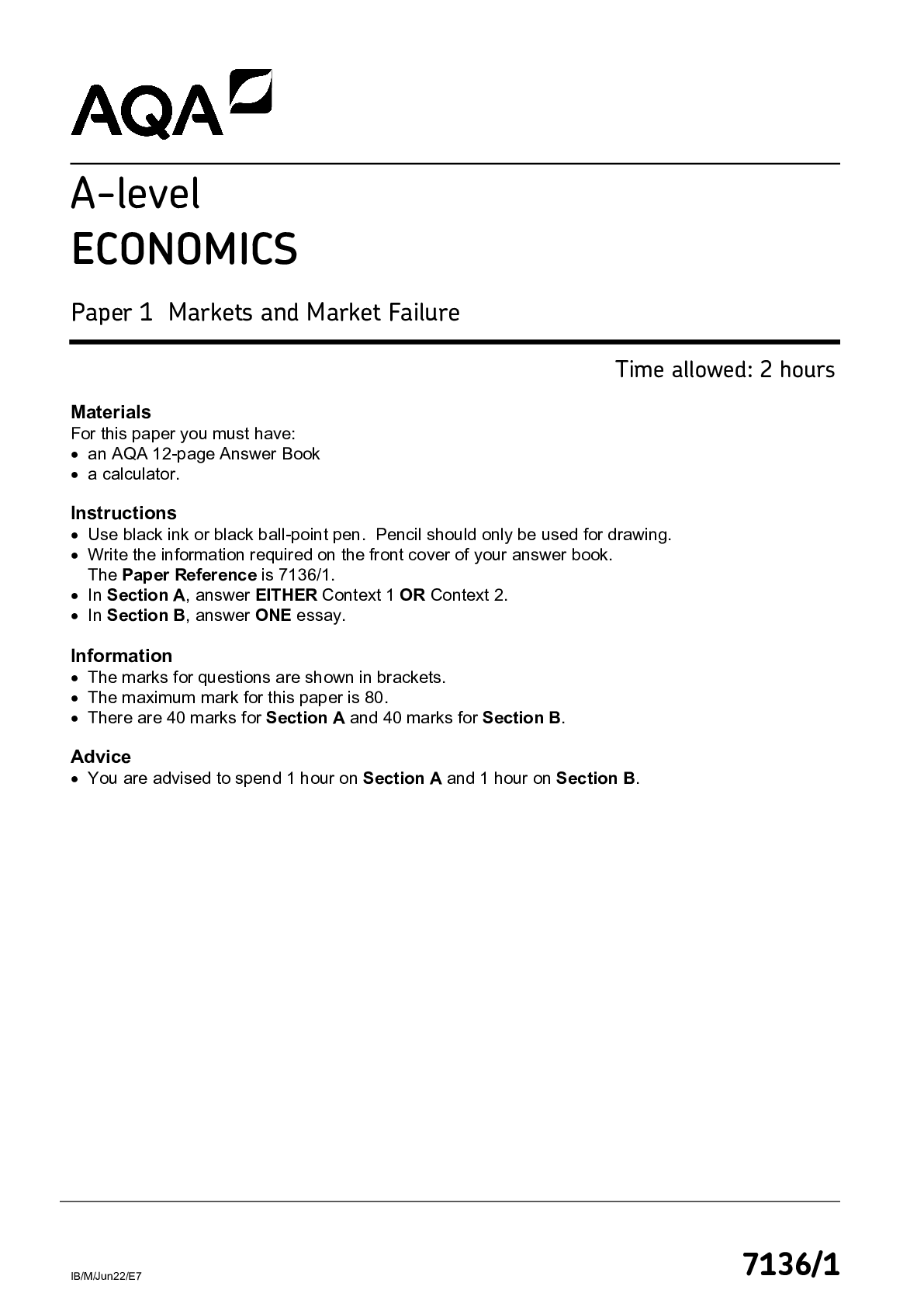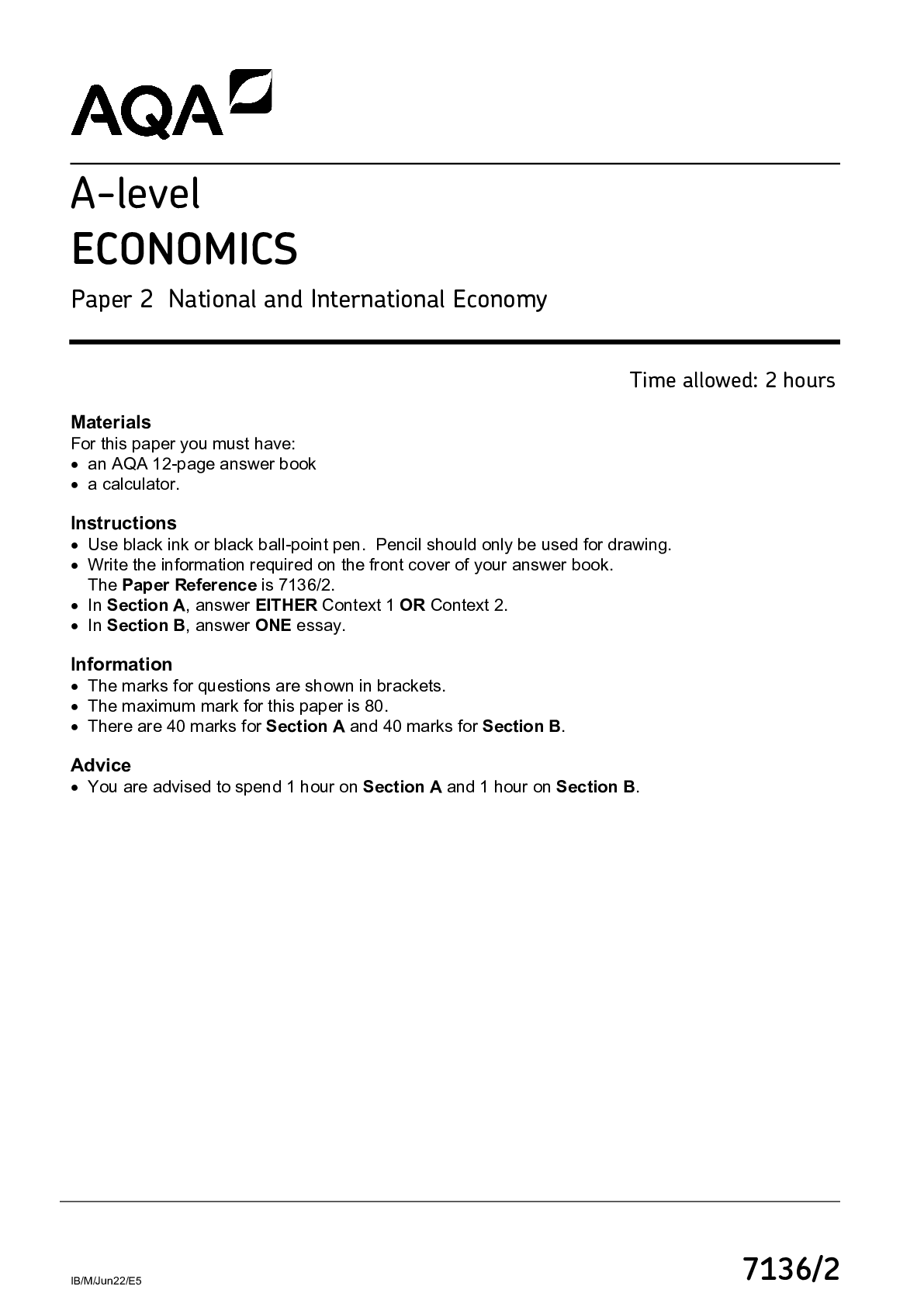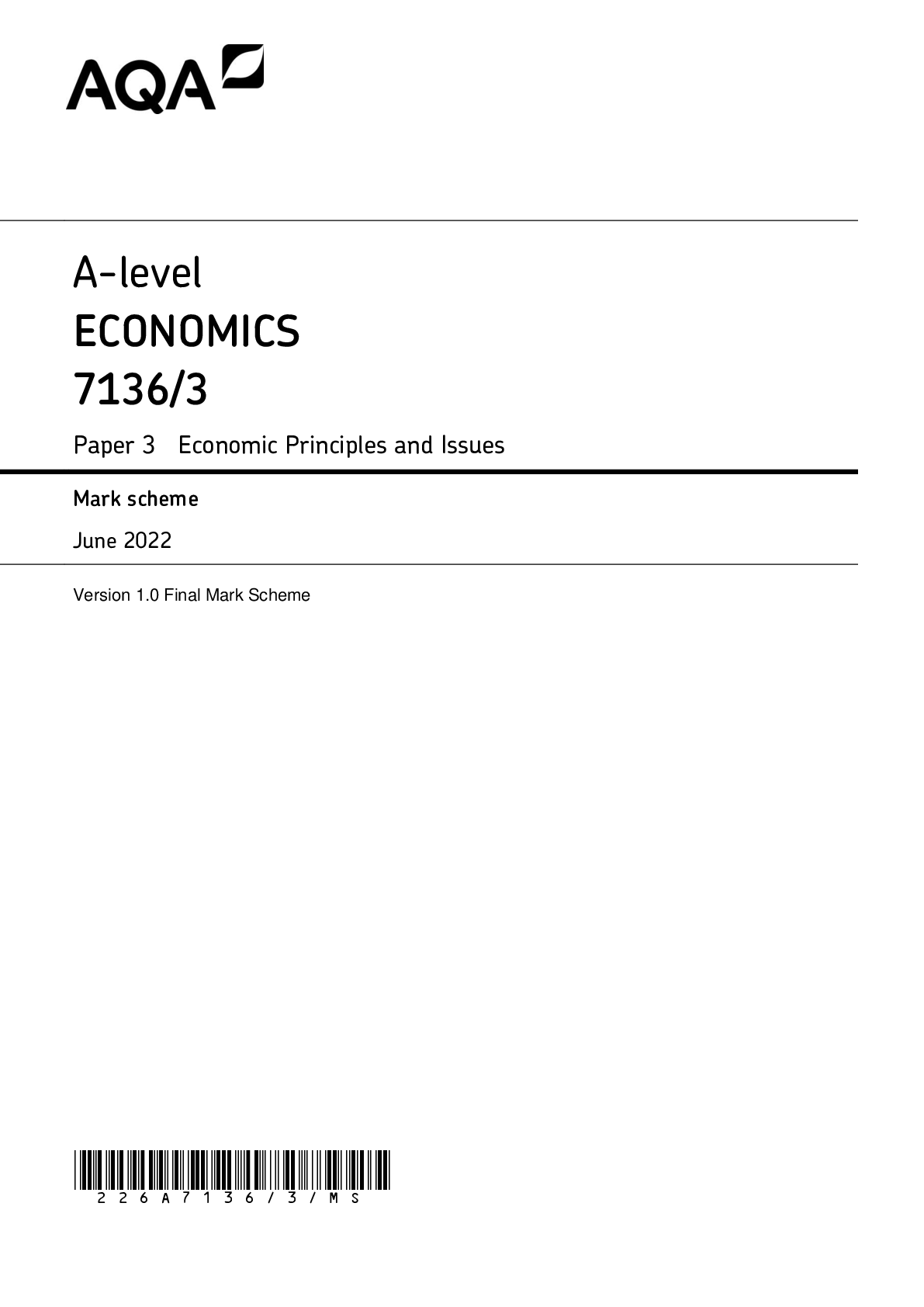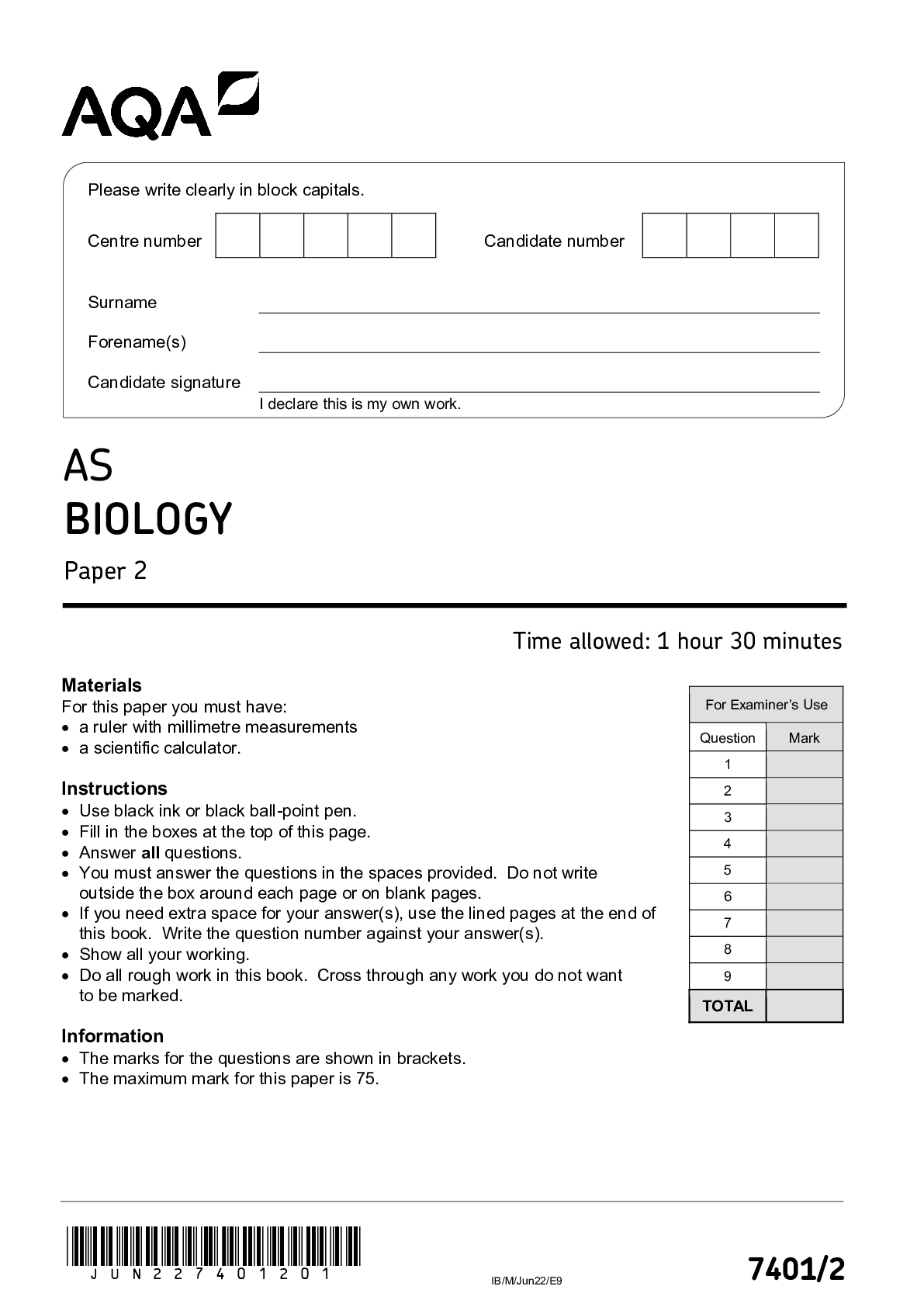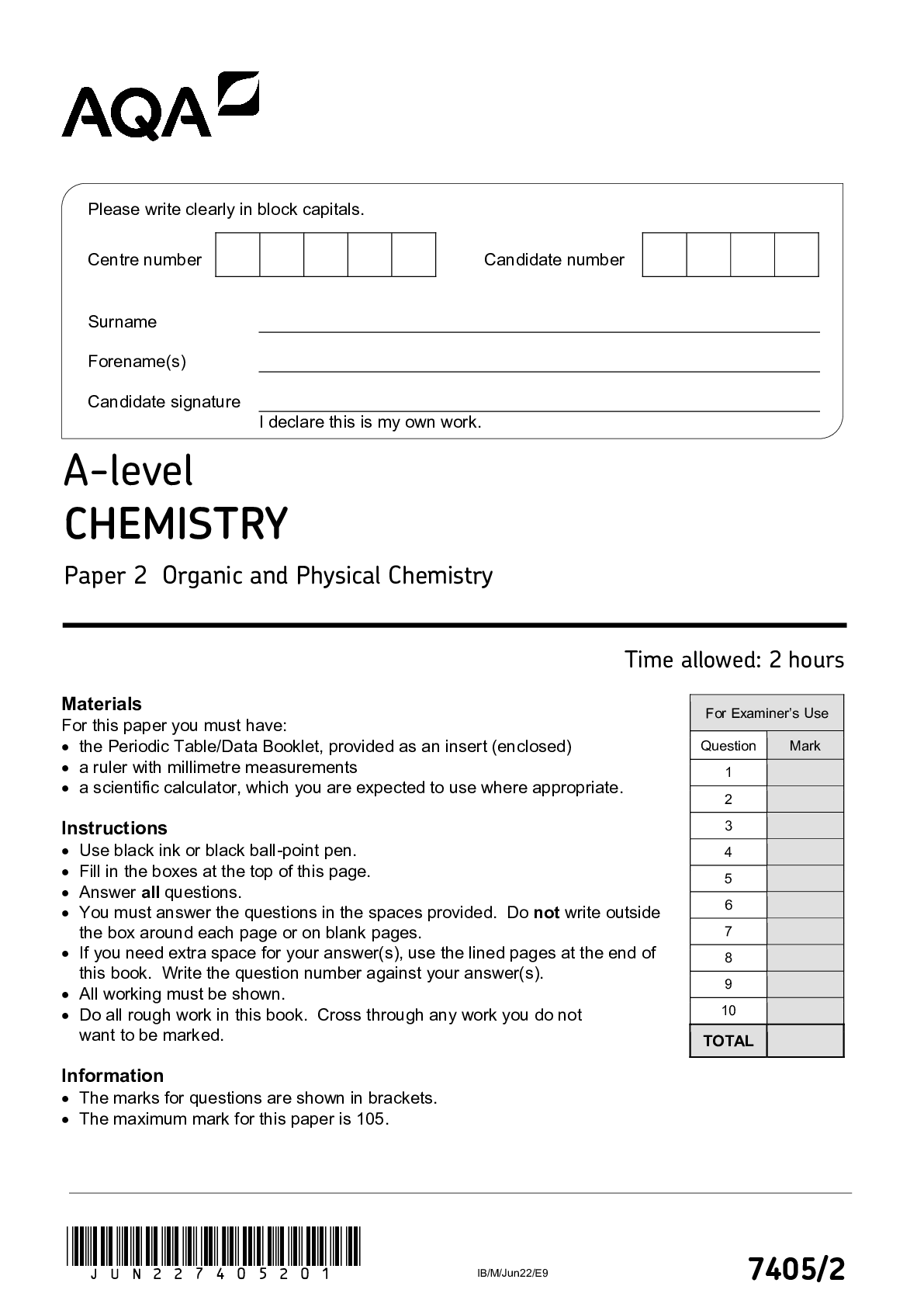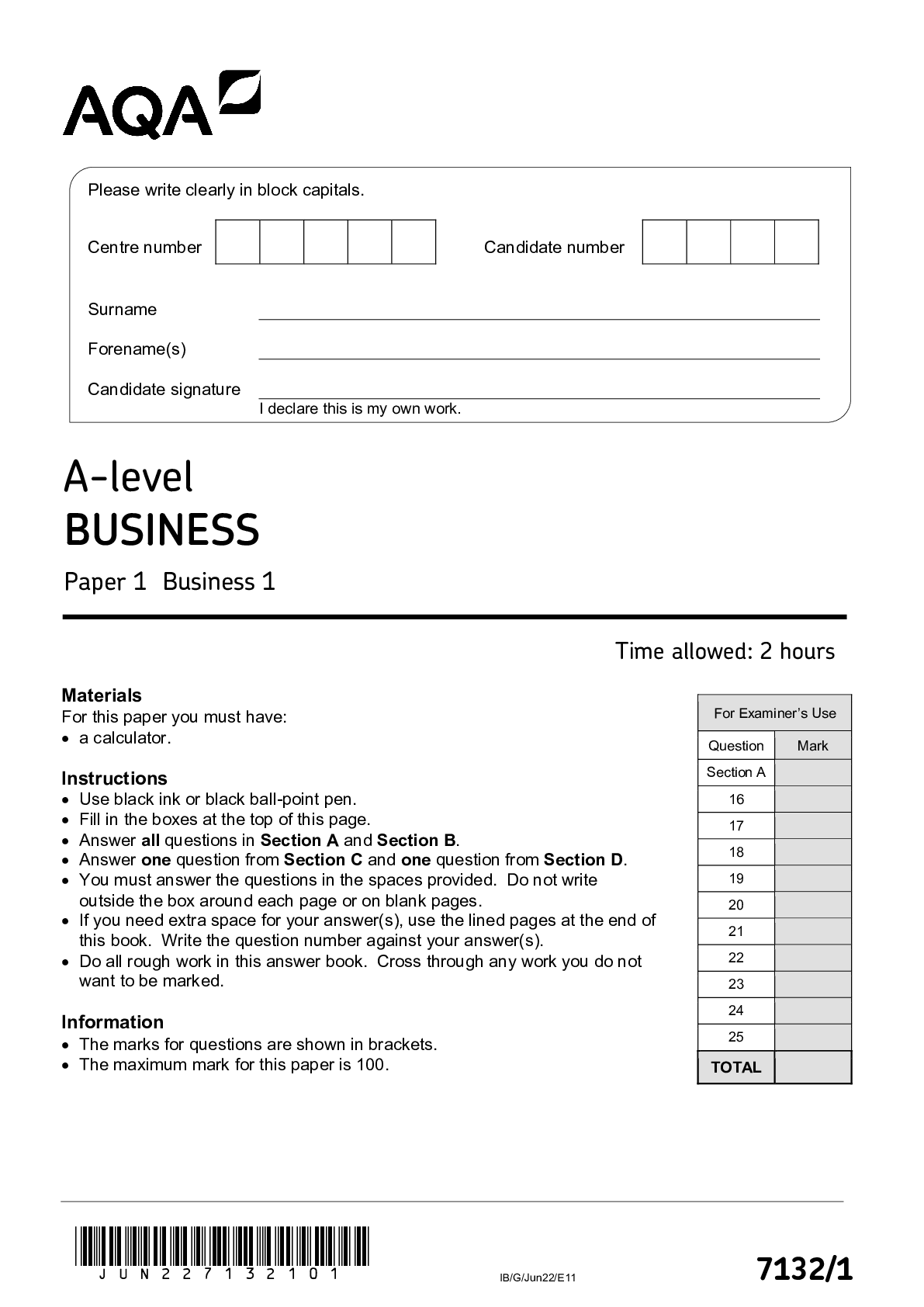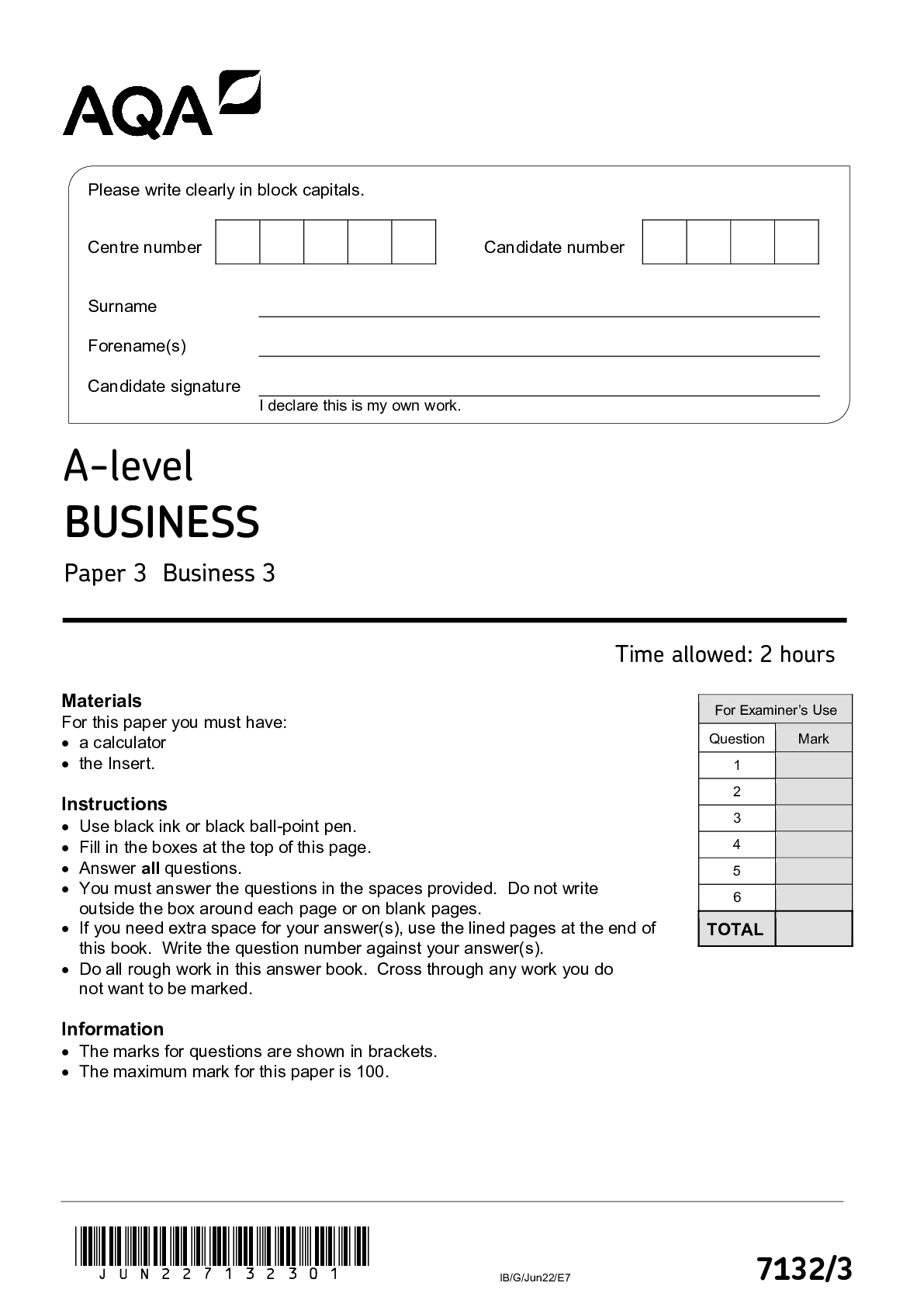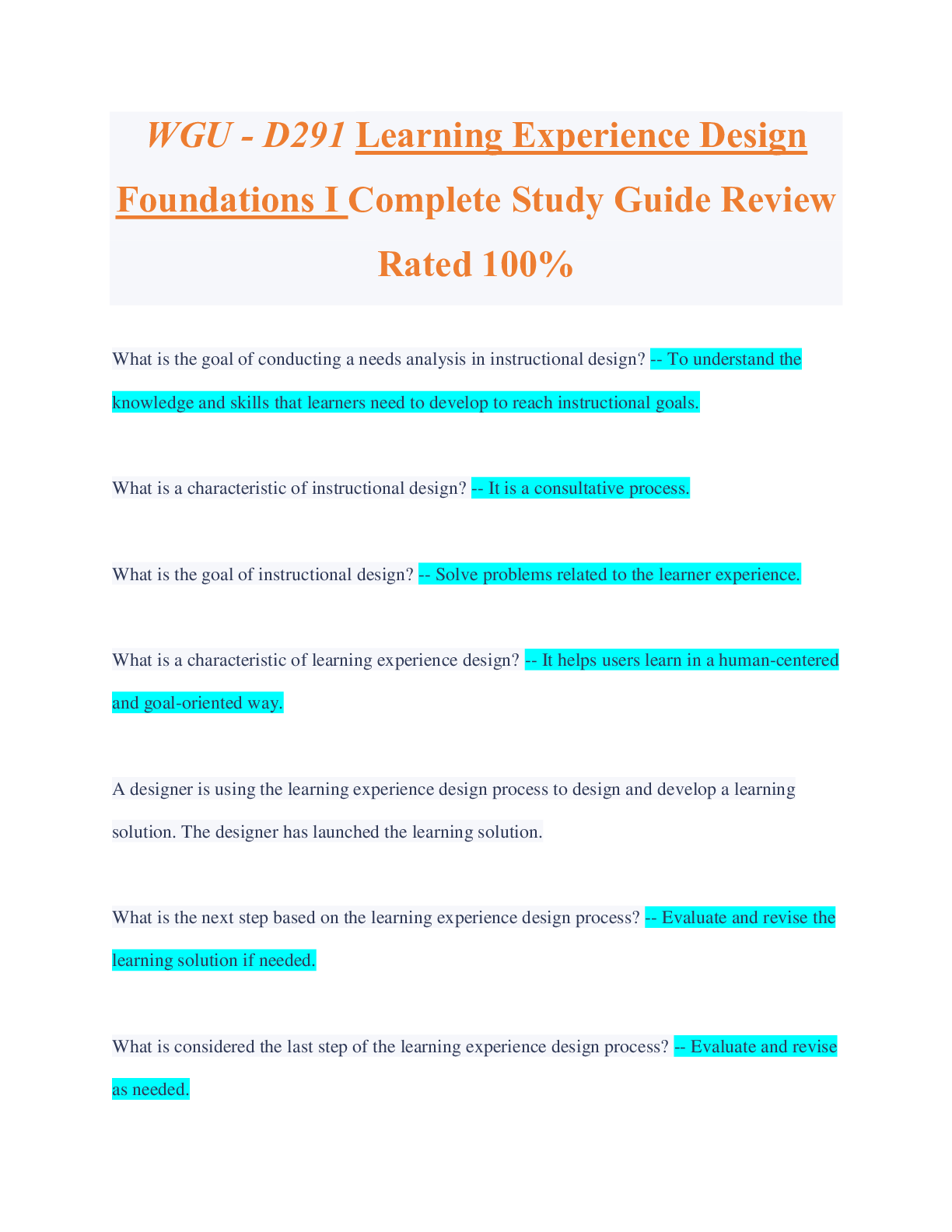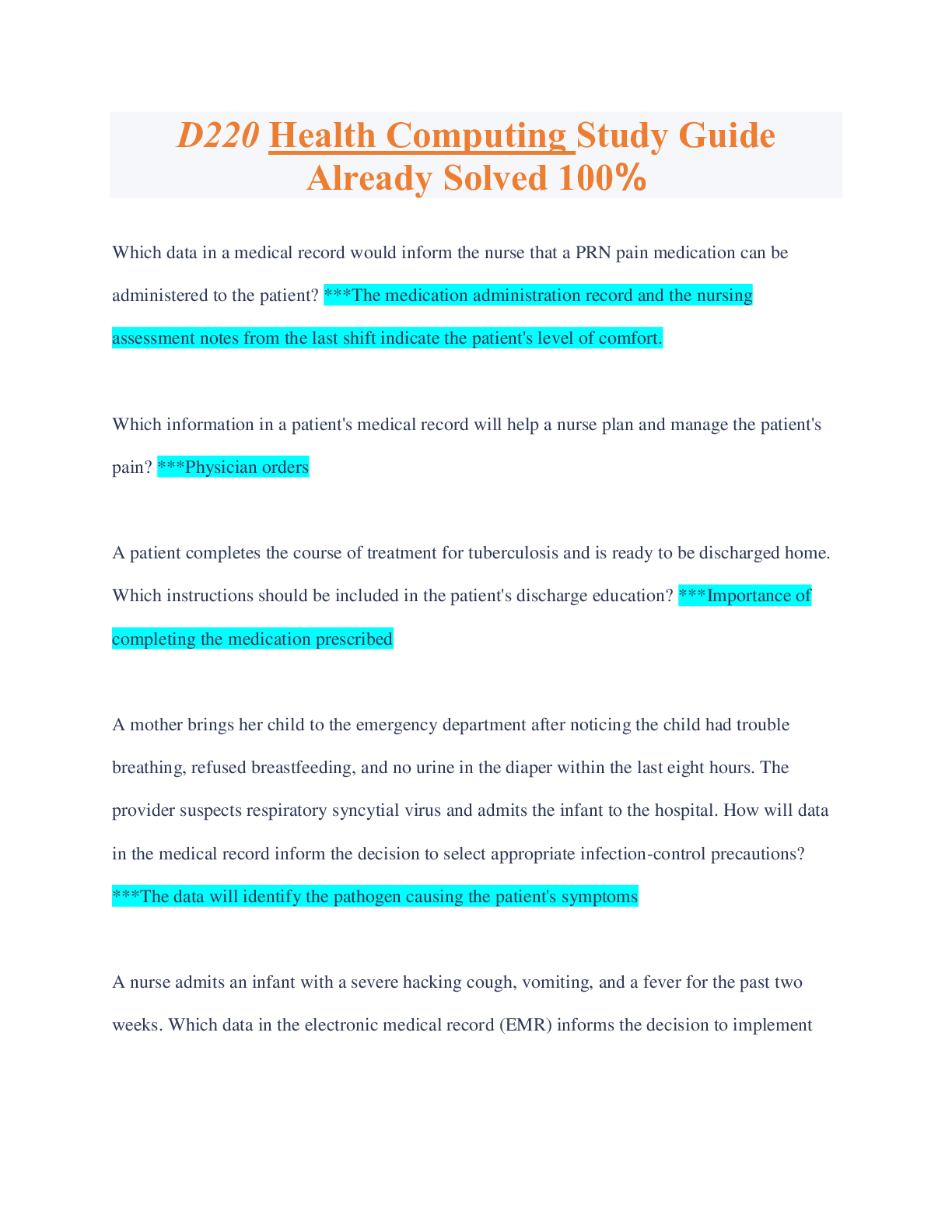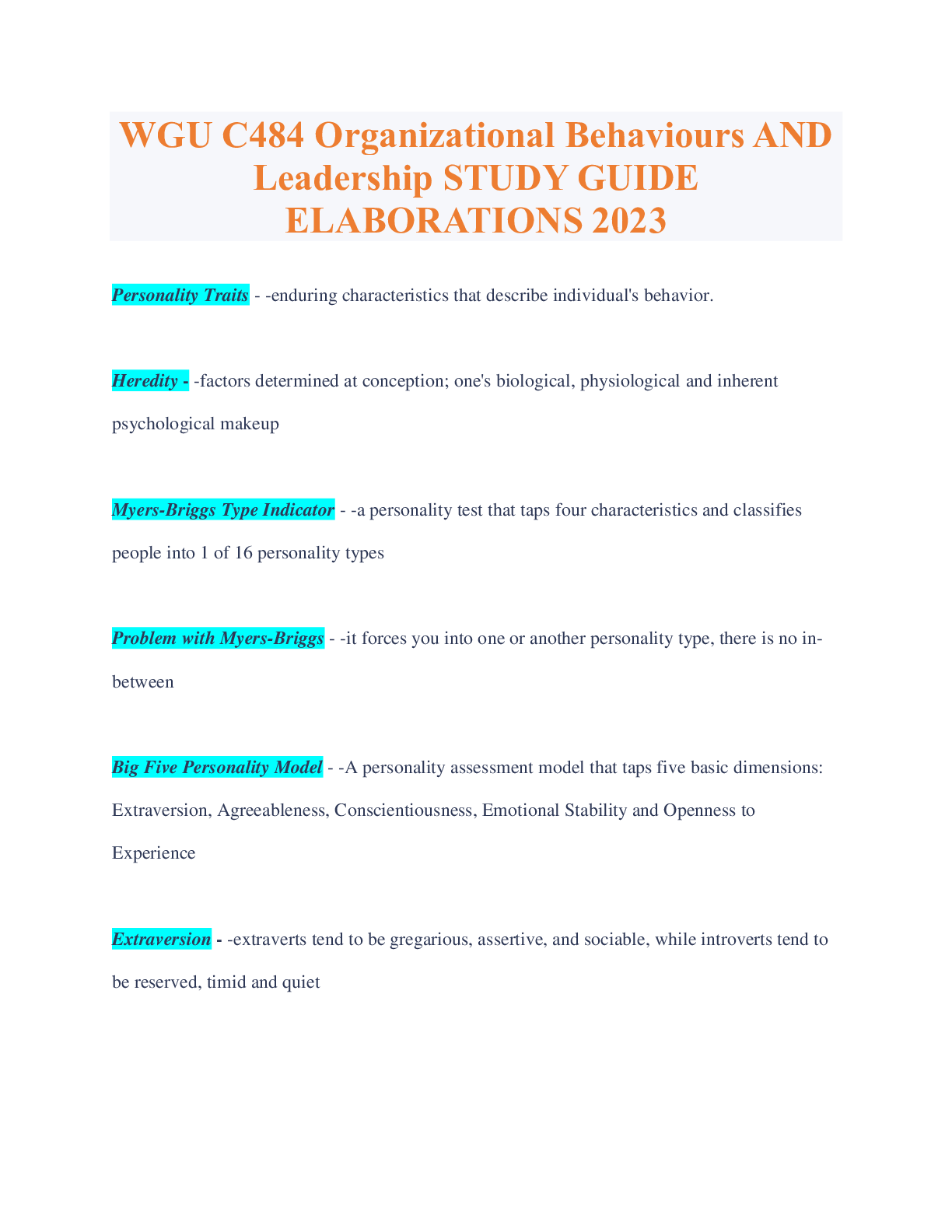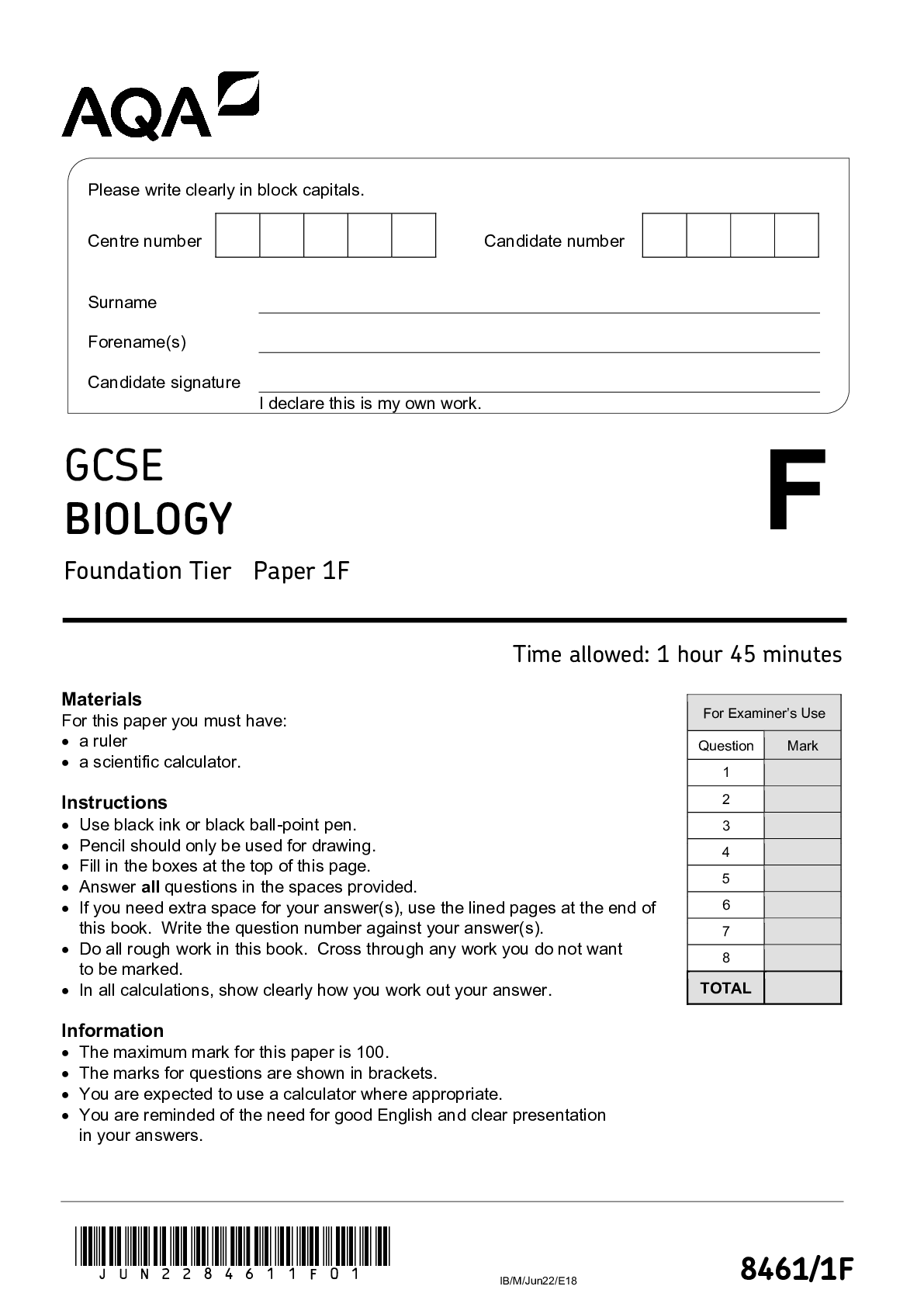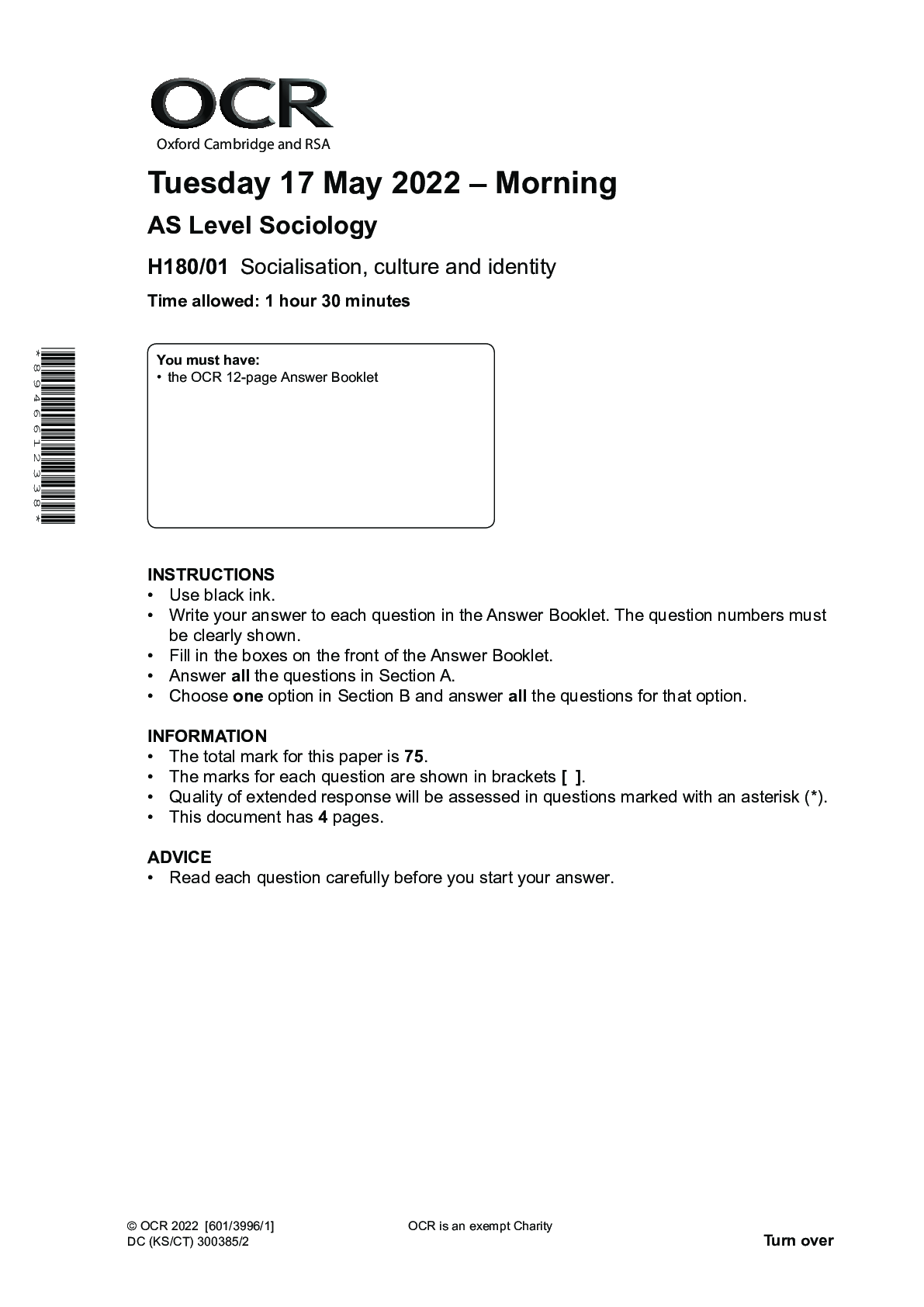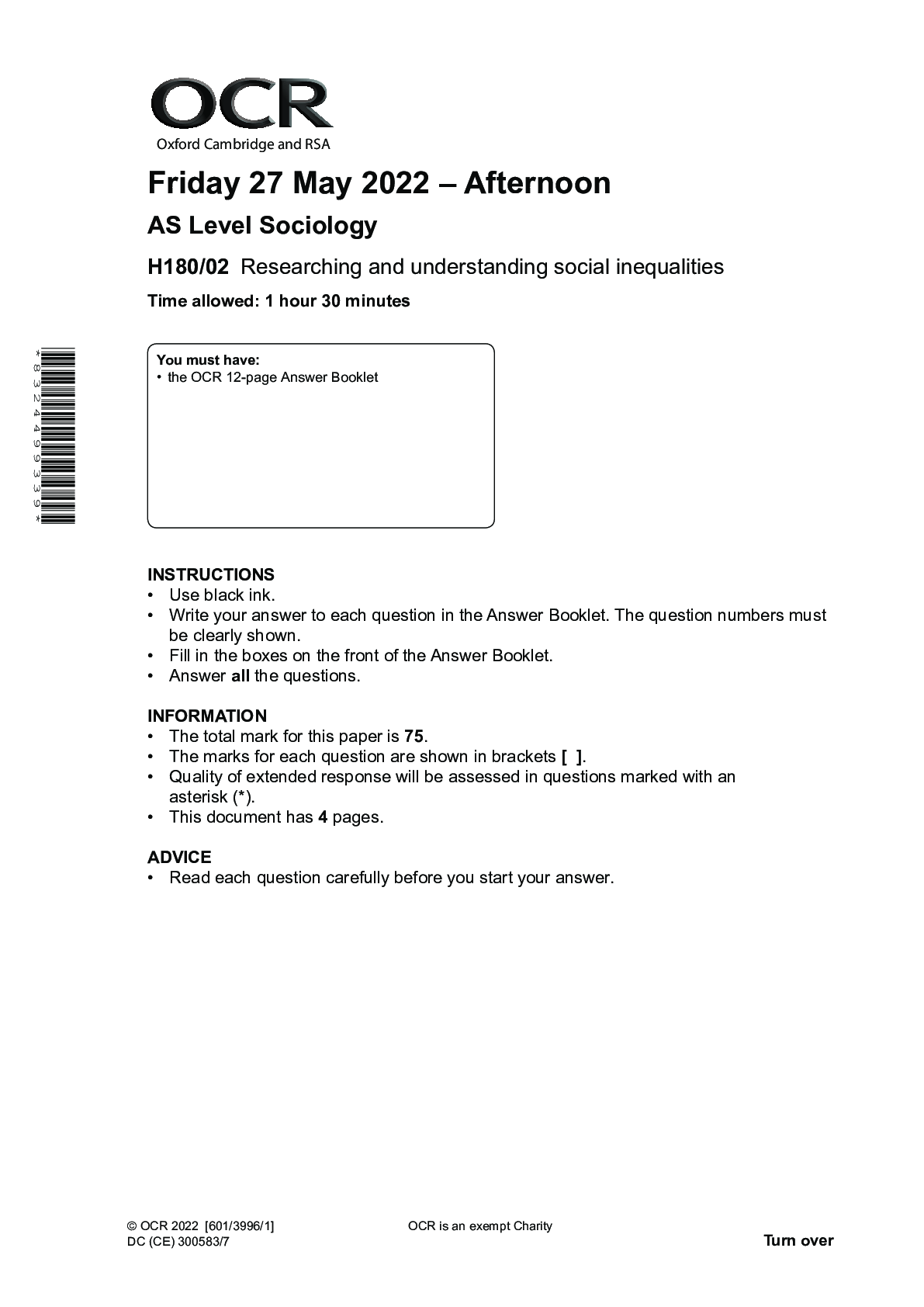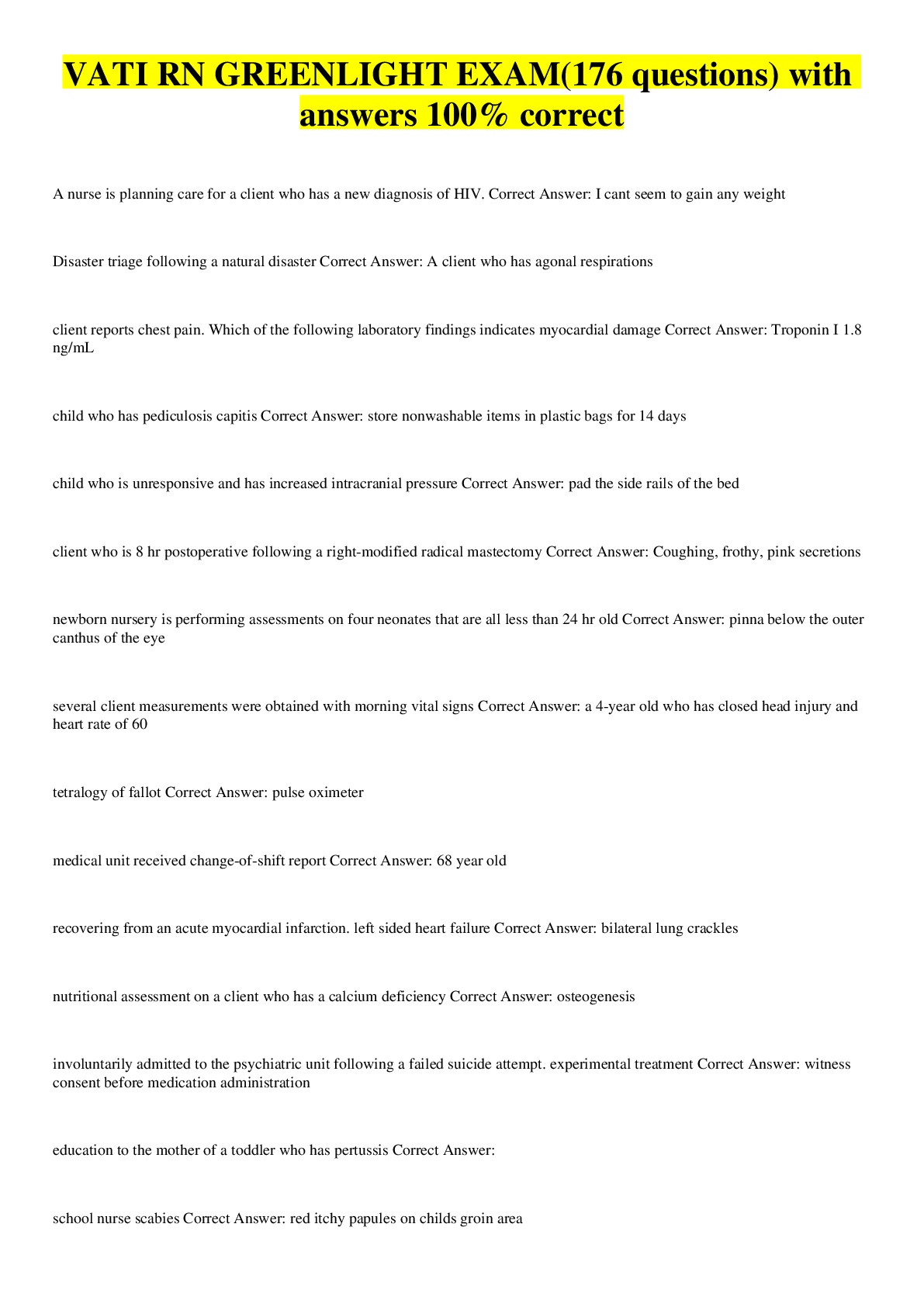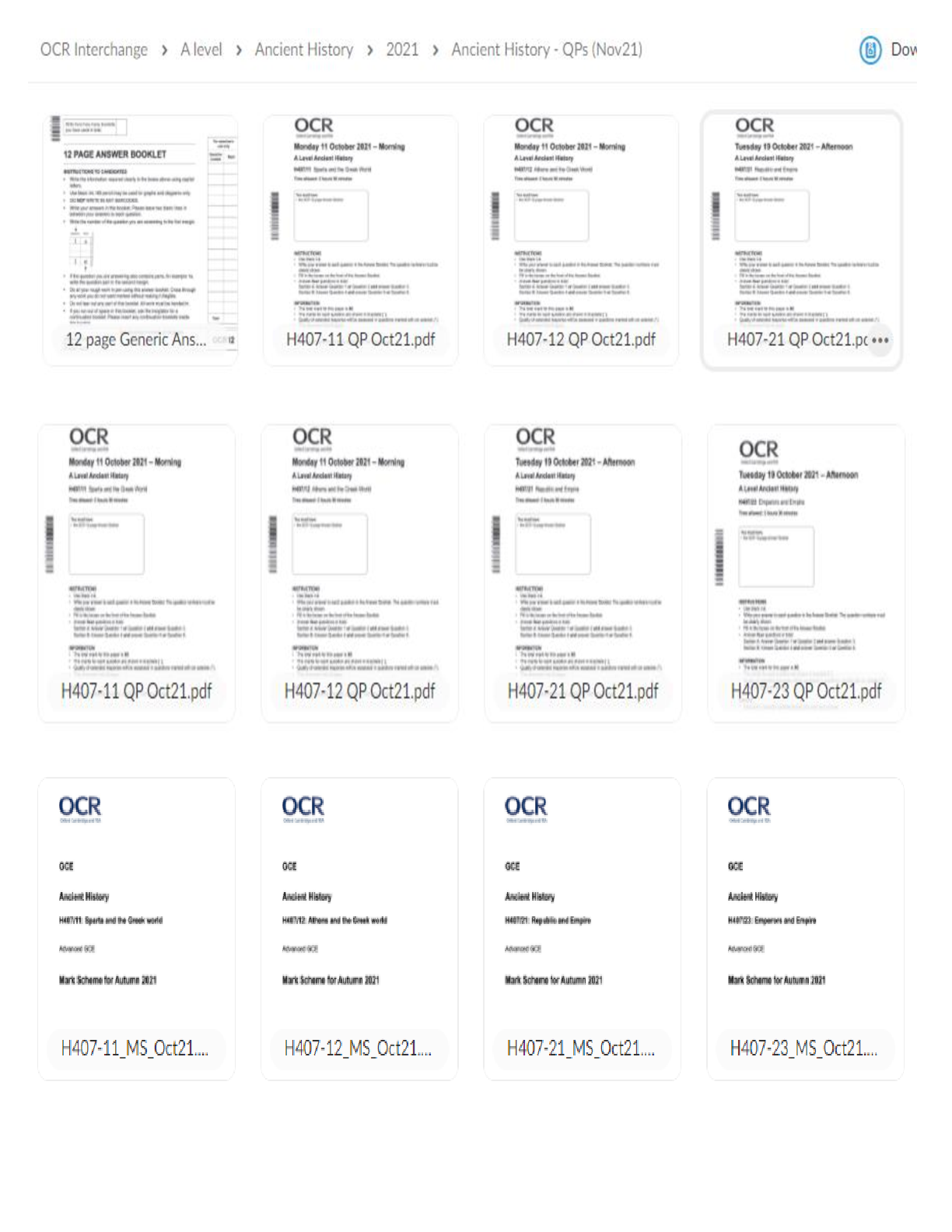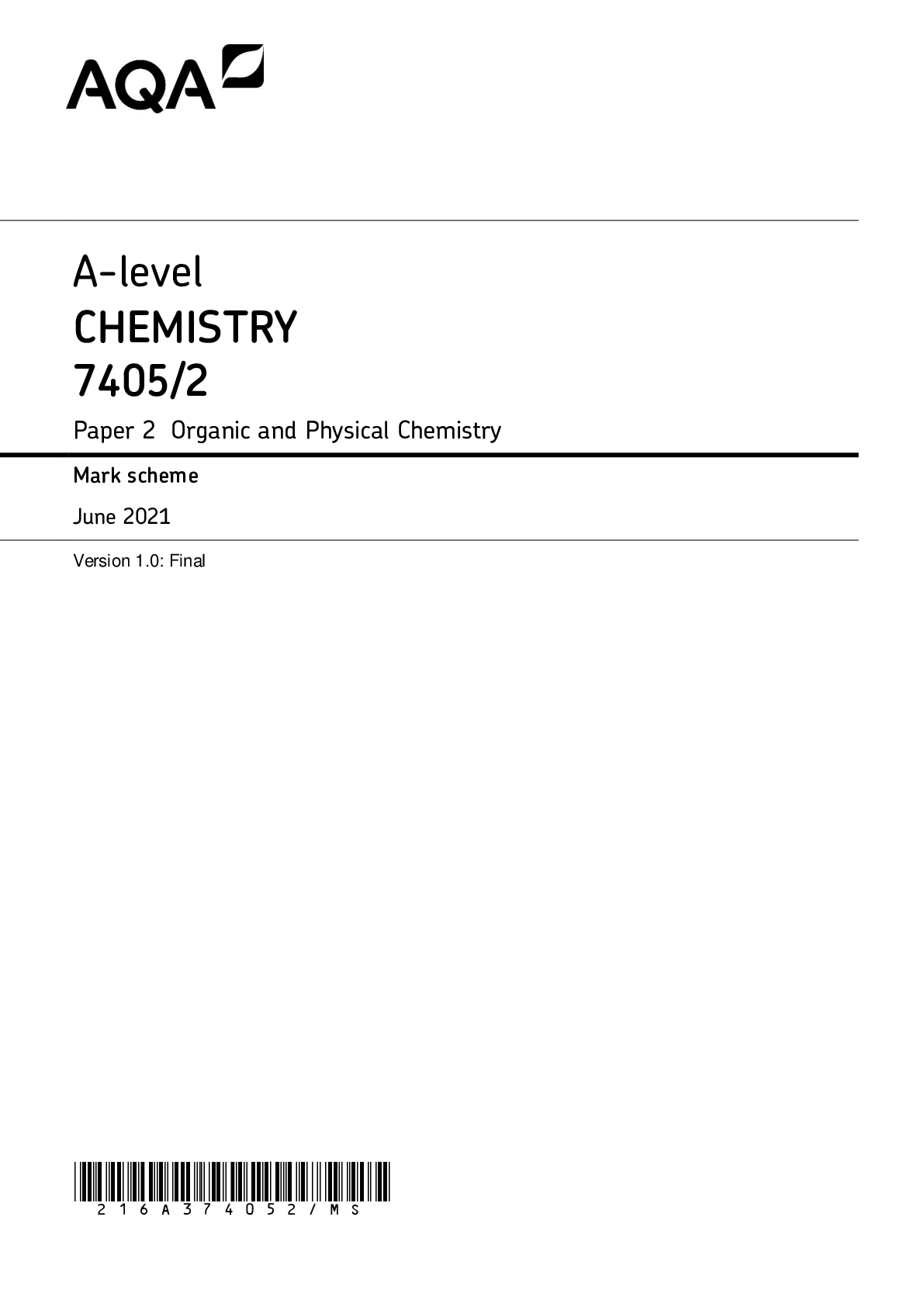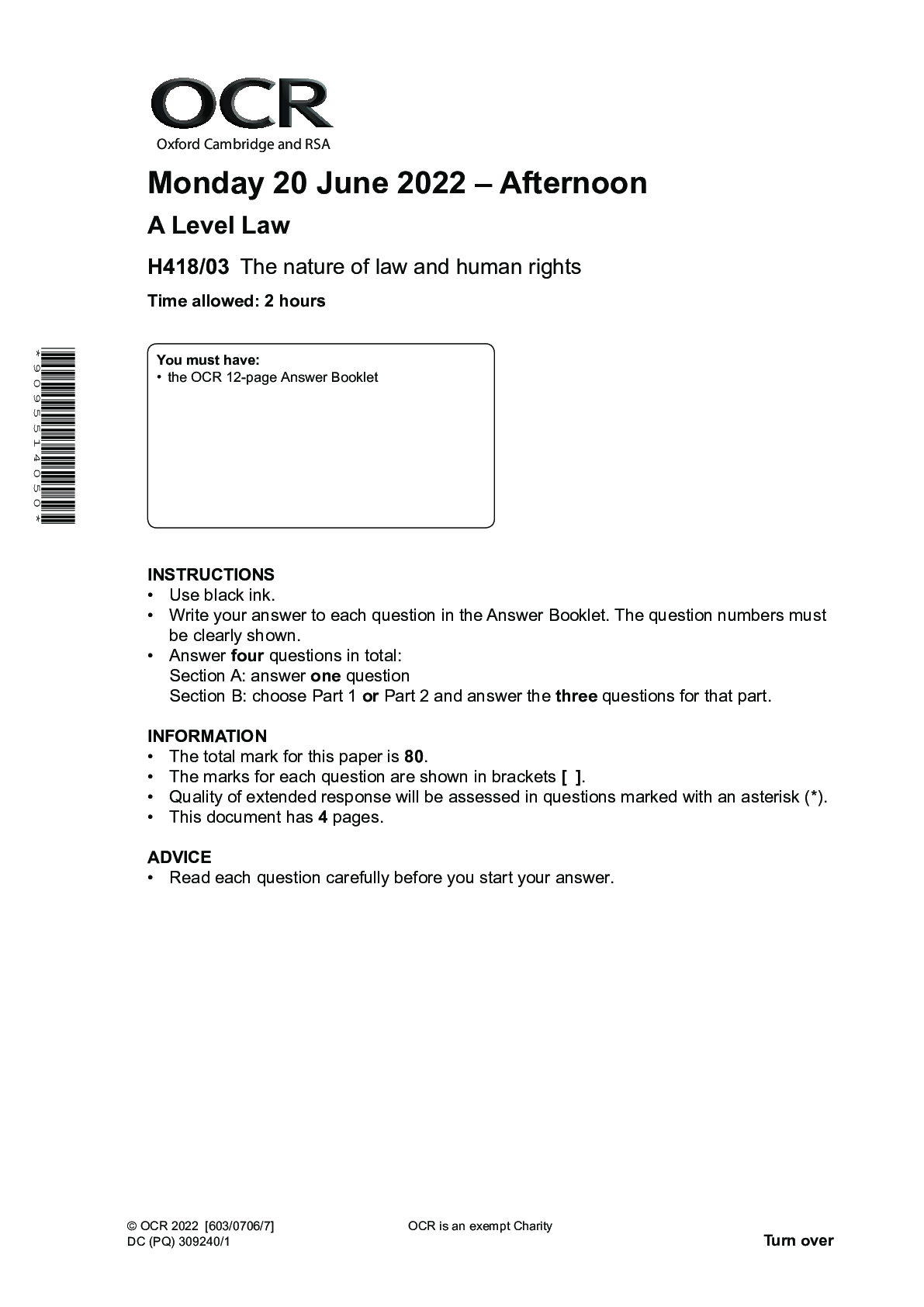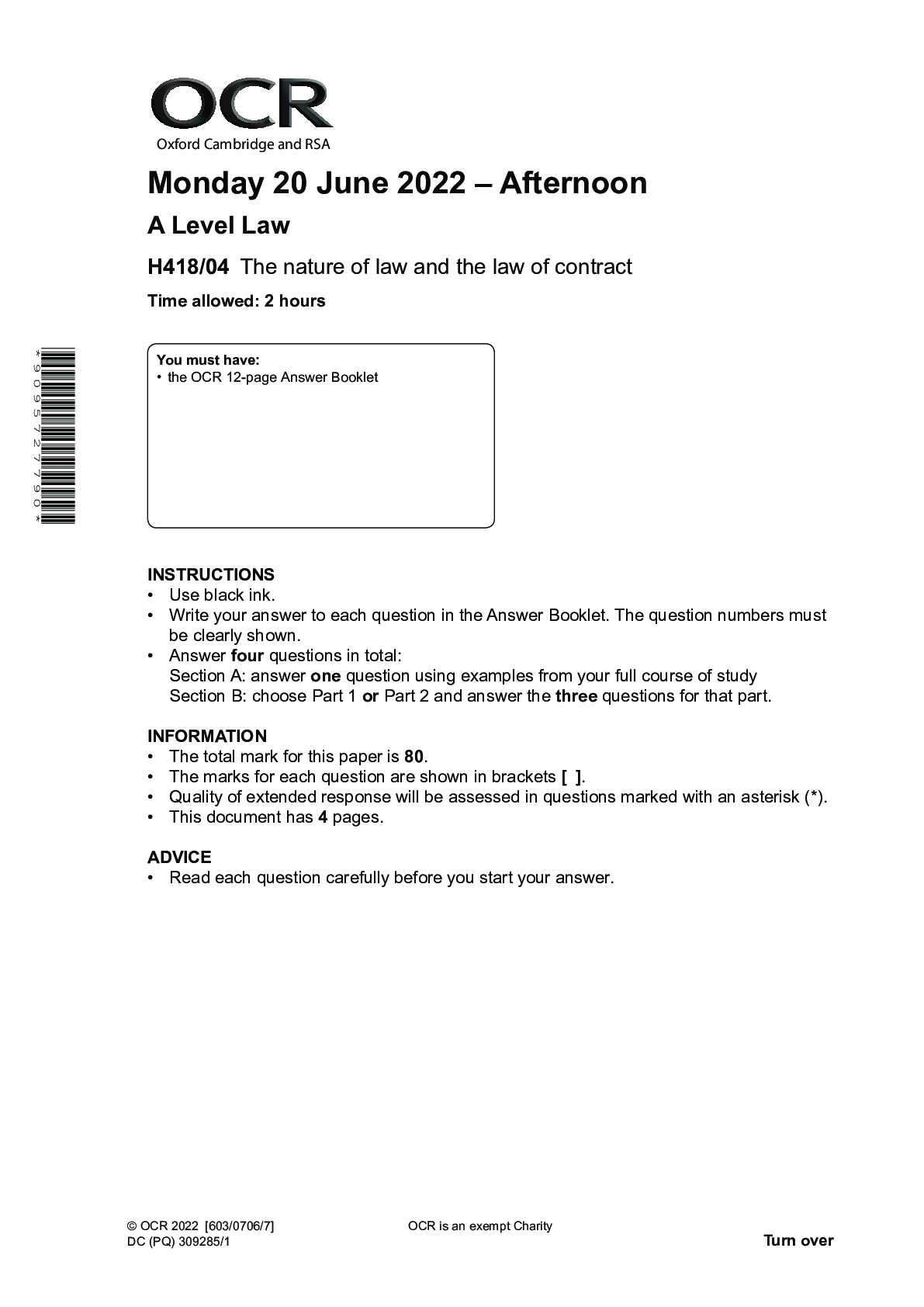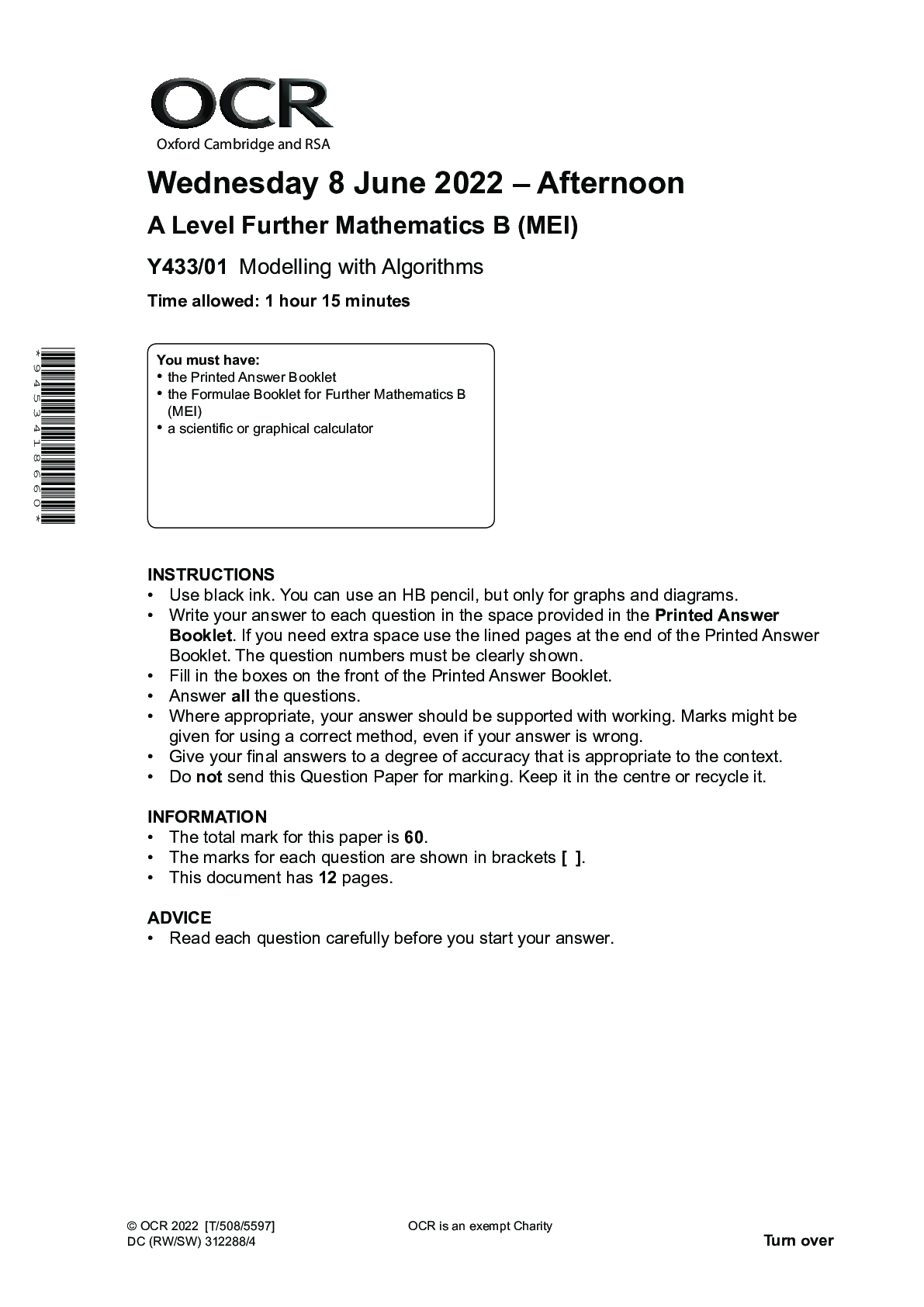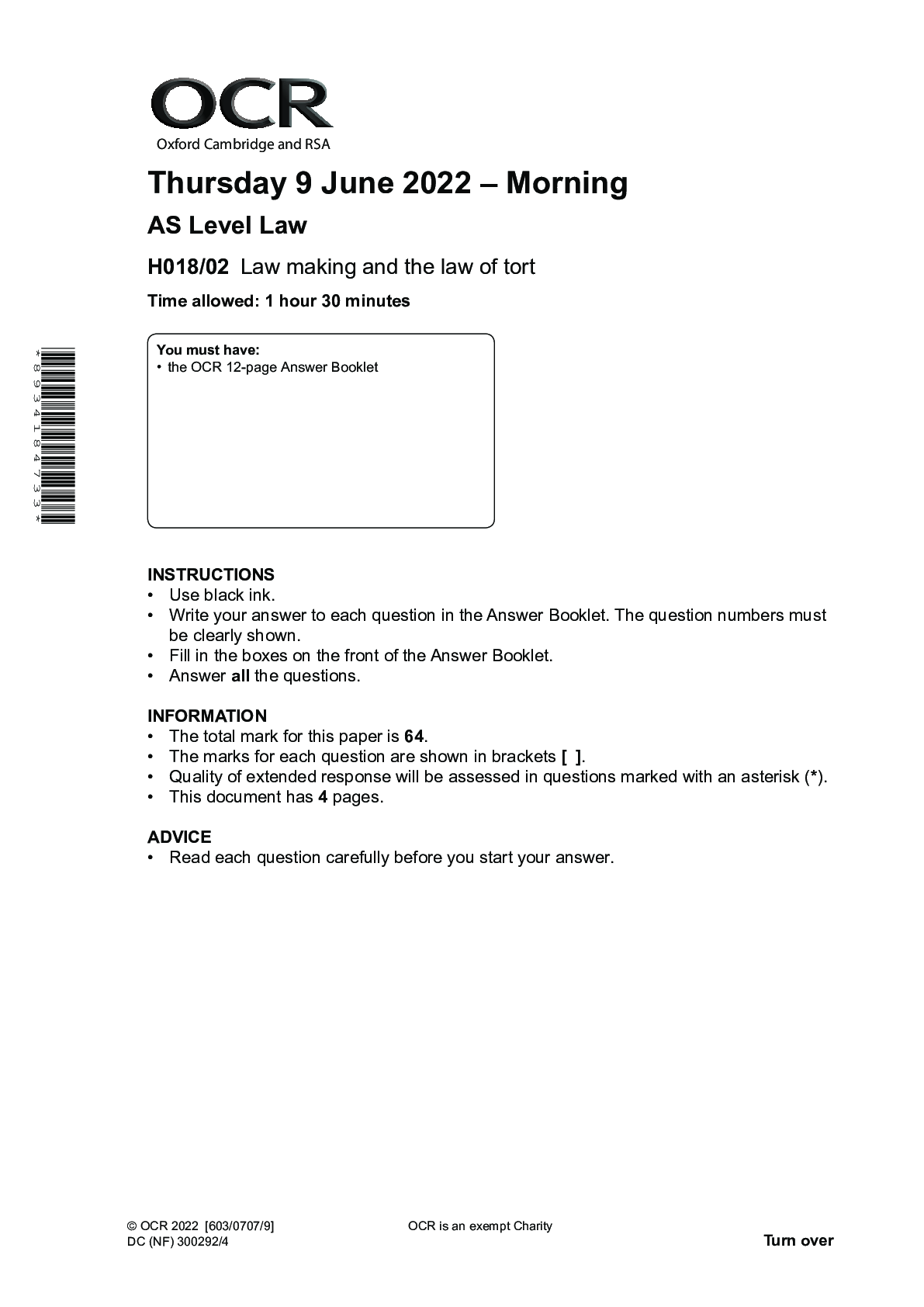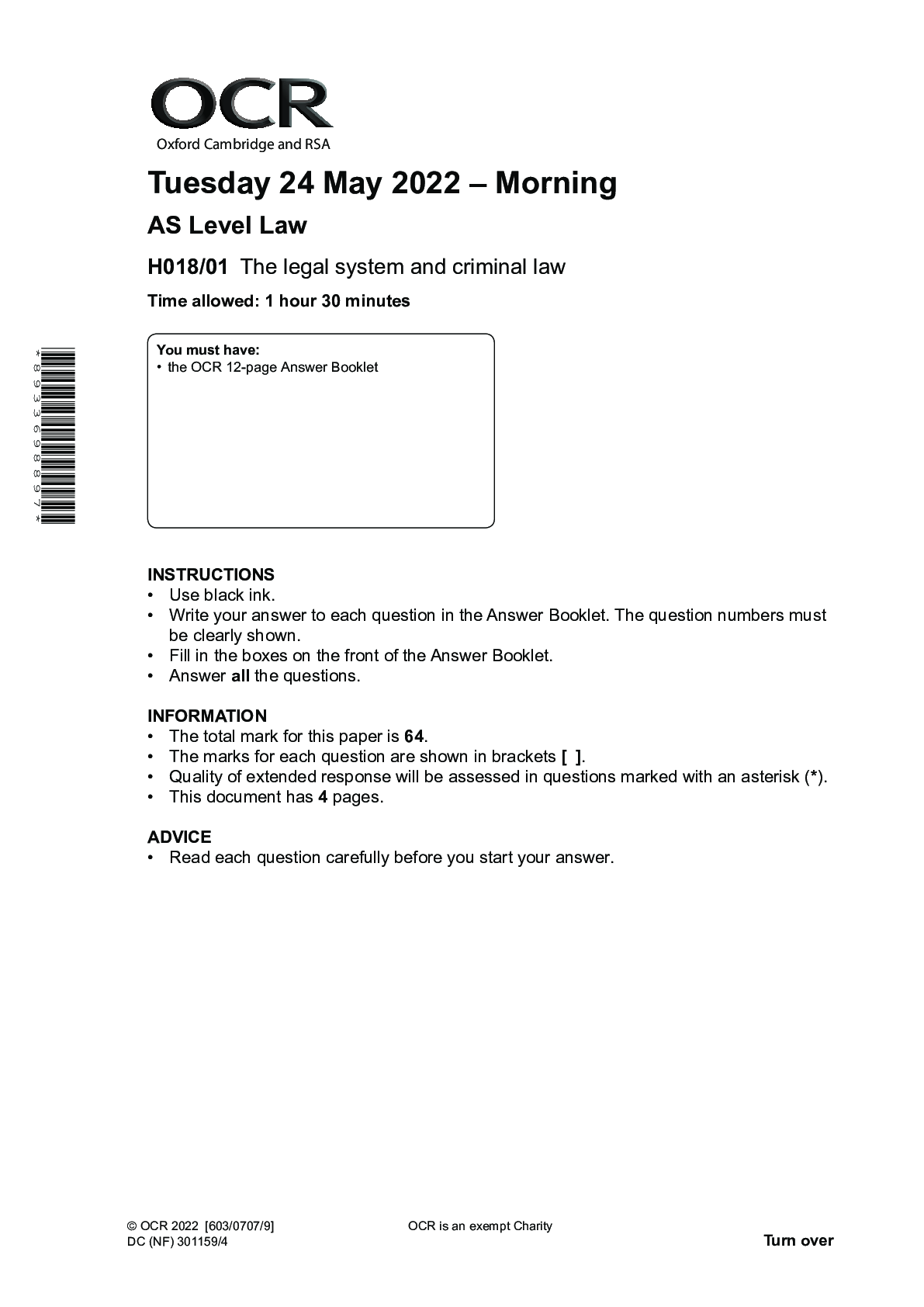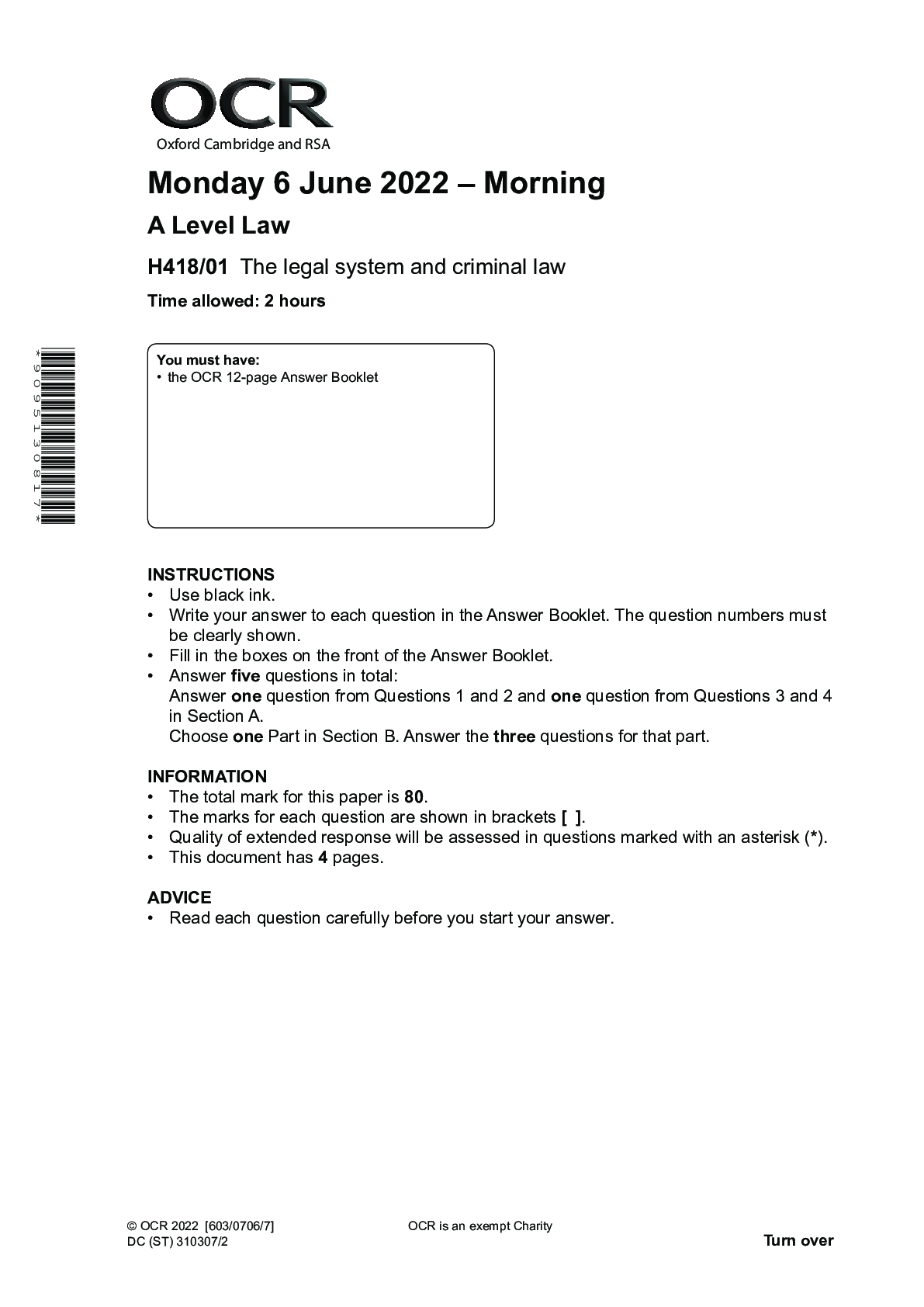Physics > AQA A/As Level Question Paper > AS PHYSICS Paper , AQA TOP NOTCH (All)
AS PHYSICS Paper , AQA TOP NOTCH
Document Content and Description Below
Materials For this paper you must have: • a pencil and a ruler • a scientific calculator • a Data and Formulae Booklet • a protractor. Instructions • Use black ink or black ball-point... pen. • Fill in the boxes at the top of this page. • Answer all questions. • You must answer the questions in the spaces provided. Do not write outside the box around each page or on blank pages. • If you need extra space for your answer(s), use the lined pages at the end of this book. Write the question number against your answer(s). • Do all rough work in this book. Cross through any work you do not want to be marked. • Show all your working. Information • The marks for questions are shown in brackets. • The maximum mark for this paper is 70. • You are expected to use a scientific calculator where appropriate. • A Data and Formulae Booklet is provided as a loose insert. Please write clearly in block capitals. Centre number Candidate number Surname Forename(s) Candidate signature I declare this is my own work. AS PHYSICS Paper 2 Time allowed: 1 hour 30 minutes You are advised to spend about 35 minutes on Section C 2 *02* IB/M/Jun22/7407/2 Do not write outside the There are no questions printed on this page box DO NOT WRITE ON THIS PAGE ANSWER IN THE SPACES PROVIDED 3 *03* Turn over ► IB/M/Jun22/7407/2 Do not write outside the Section A box Answer all questions in this section. 0 1 Figure 1 shows apparatus used to determine the acceleration g due to gravity by a free-fall method. Figure 1 When the switch is opened a timer starts and a steel ball is released from rest. The ball falls vertically onto an impact switch and this stops the timer. The timer displays the time t for the ball to fall through the vertical distance s shown in Figure 1. Question 1 continues on the next page 4 *04* IB/M/Jun22/7407/2 Do not write outside the box A student obtains values of t for different values of s. The student plots the graph of 2s against t 2 shown in Figure 2. Figure 2 5 *05* Turn over ► IB/M/Jun22/7407/2 Do not write outside the 0 1 box . 1 The student has used an absolute uncertainty in s to draw the vertical error bars in Figure 2. Deduce the student’s absolute uncertainty in s. [1 mark] absolute uncertainty in s = m 0 1 . 2 Determine • the maximum gradient Gmax of a straight line that passes through all the error bars • the minimum gradient Gmin of a straight line that passes through all the error bars. [3 marks] Gmax = Gmin = Question 1 continues on the next page 6 *06* IB/M/Jun22/7407/2 Do not write outside the 0 1 box . 3 It can be shown that 2s = gt2 . Determine a value for g using Gmax and Gmin. [2 marks] g = m s−2 0 1 . 4 Determine the percentage uncertainty in your value for g. [2 marks] percentage uncertainty = % 7 *07* Turn over ► IB/M/Jun22/7407/2 Do not write outside the A fault develops in the apparatus. box When the switch is opened there is now a 30 ms delay before the ball is released. 0 1 . 5 State the type of error produced by this fault. [1 mark] 0 1 . 6 A graph of 2s against t 2 is produced using results from the faulty apparatus. Describe how this graph is different from the graph in Figure 2. [1 mark] Turn over for the next question 10 8 *08* IB/M/Jun22/7407/2 Do not write outside the 0 2 box Figure 3 shows a circuit used to find the resistance per unit length of a copper wire. Figure 3 The copper wire is fixed with tape to a metre ruler that has 2 mm graduations. Contact P is placed on the wire close to one end of the ruler and held firmly in place using a bulldog clip. When contact Q is placed on the wire as shown in Figure 3 the voltmeter shows a non-zero reading. 9 *09* Turn over ► IB/M/Jun22/7407/2 Do not write outside the Q box is moved along the wire until the voltmeter reading is zero. Figure 4 shows enlarged views of the position of P and the new position of Q. Figure 4 0 2 . 1 Determine, in m, the length x of copper wire between P and Q. [1 mark] x = m Question 2 continues on the next page 10 *10* IB/M/Jun22/7407/2 Do not write outside the 0 2 box . 2 When the voltmeter reading is zero: 1 3 2 4 = R R R R where R4 is the resistance of the copper wire between P and Q. Determine, in Ω m−1 , the resistance per unit length of the copper wire. R1 = 2.2 MΩ R2 = 3.9 kΩ R3 = 75 Ω [2 marks] resistance per unit length = Ω m−1 0 2 . 3 The diameter d of the copper wire is approximately 0.4 mm. Suggest: • a suitable measuring instrument to accurately determine d • how to reduce the effect of random error on the result for d. [3 marks] 11 *11* Turn over ► IB/M/Jun22/7407/2 Do not write outside the 0 2 box . 4 Determine the resistivity ρ of copper. diameter d of the copper wire = 0.38 mm [2 marks] ρ = Ω m The copper wire is replaced with a constantan wire of diameter 0.38 mm. = 30 resistivity of constantan resistivity of copper 0 2 . 5 Suggest one change to the circuit to make the voltmeter read zero for the same value of x as in Question 02.1. [1 mark] 0 2 . 6 Calculate, in mm, the diameter of a constantan wire that has the same resistance per unit length as the copper wire. [1 mark] diameter = mm END OF SECTION A 10 12 *12* IB/M/Jun22/7407/2 Do not write outside the There are no questions printed on this page box DO NOT WRITE ON THIS PAGE ANSWER IN THE SPACES PROVIDED 13 *13* Turn over ► IB/M/Jun22/7407/2 Do not write outside the Section B box Answer all questions in this section. 0 3 A student buys a portable loudspeaker that is powered by its own internal battery. The battery in the loudspeaker is initially uncharged. 0 3 . 1 The battery is connected to a charger that maintains a constant potential difference of 5.0 V across the battery. It takes 2.6 hours for the battery to become fully charged. The average current in the battery during this time is 2.0 A. The battery is disconnected from the charger. The fully-charged battery operates the loudspeaker for 12 hours before it is completely discharged. Calculate the average output power of the battery during these 12 hours. [2 marks] average output power = W 0 3 . 2 A mobile phone transmits data to the loudspeaker using microwaves. The data are processed at the loudspeaker to produce sound waves. Microwaves and sound waves travel at different speeds. Describe two other differences between microwaves and sound waves. [2 marks] 1 2 Question 3 continues on the next page 14 *14* IB/M/Jun22/7407/2 Do not write outside the 0 3 box . 3 A second loudspeaker receives the same data from the mobile phone. The two loudspeakers act as coherent sources of sound waves. State the two conditions required for the sources to be coherent. [2 marks] 1 2 Figure 5 shows two loudspeakers A and B that act as coherent point sources of sound of a single frequency. Figure [Show More]
Last updated: 1 year ago
Preview 1 out of 40 pages
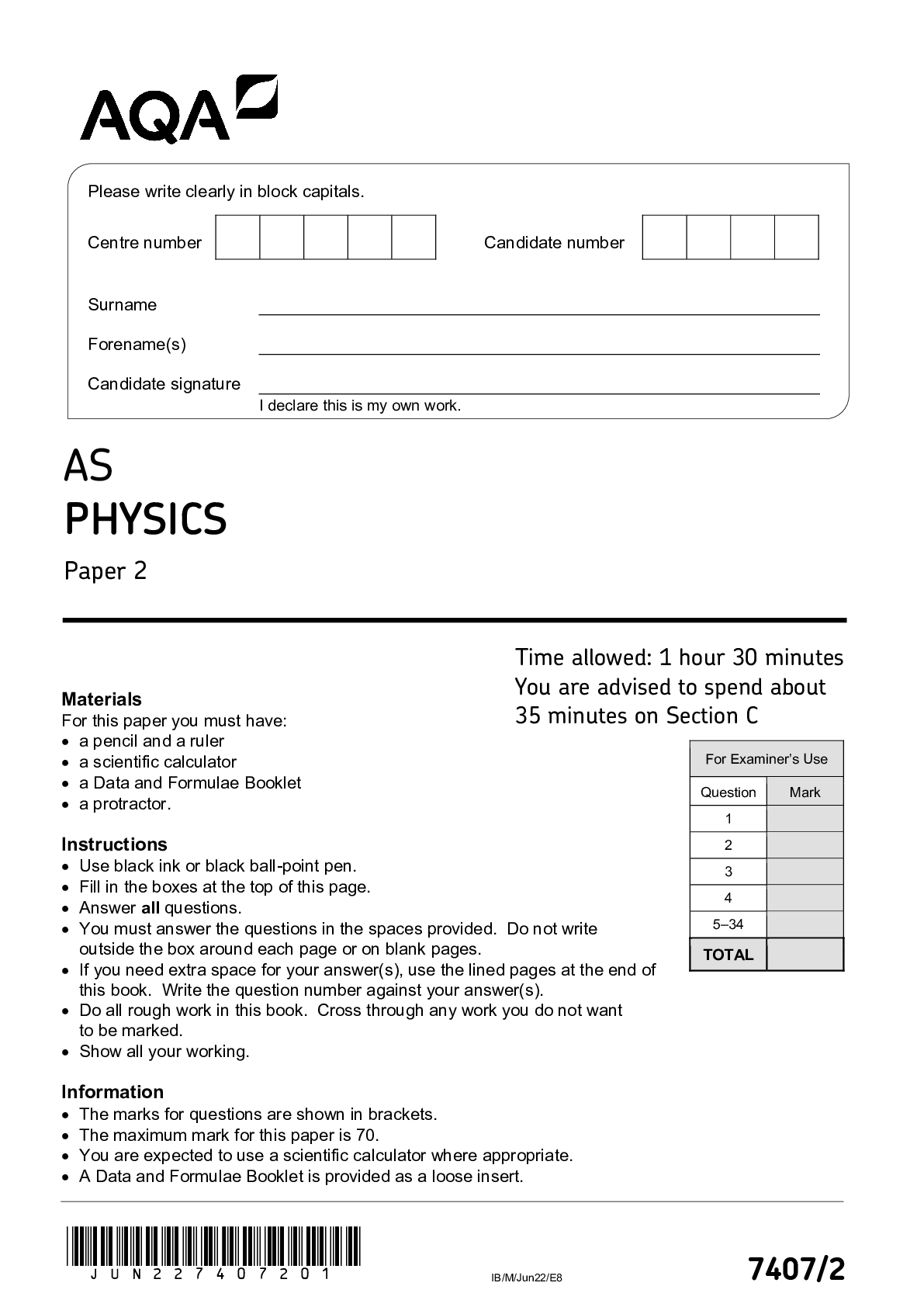
Reviews( 0 )
Document information
Connected school, study & course
About the document
Uploaded On
Apr 01, 2023
Number of pages
40
Written in
Additional information
This document has been written for:
Uploaded
Apr 01, 2023
Downloads
0
Views
89

